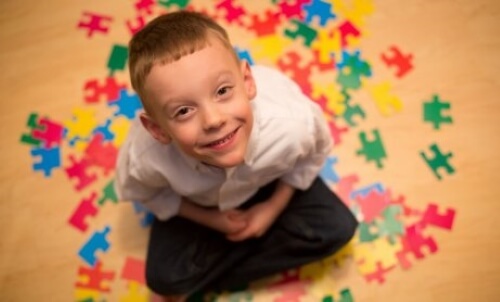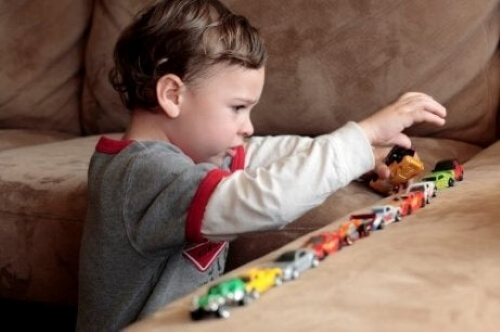Characteristics of Autism Spectrum Disorder


Written and verified by the psychologist Ana Couñago
Children with Autism Spectrum Disorder develop differently than other children in the emotional and cognitive domains. Children who have ASD have a different way of seeing the world, and because of this, their way of behaving themselves can seem awkward and unexpected at times.
To understand some of the key defining traits, we’ve created this article about Autism Spectrum Disorder. You have to keep in mind that the earlier you intervene to help children with ASD, the better the prognosis and likelihood of achieving good results. To start the intervention, first you have to know what to look for and how to recognize ASD conditions.
“Persons with autism see the world in a different light, in ways that many cannot imagine.”
– Tina J Richardson –
The definition of Autism Spectrum Disorder
The first designation considered relevant among the disorders included in the Autism Spectrum Disorder are those that were developed by Leo Kanner and Hans Asperger in 1943 and 1944.
This group of disorders is referred to as a spectrum because these disorders manifest in terms of a continuum. The characteristic symptoms of autism can manifest in very diverse ways in each individual. As a result, there is a wide range of variation among the group of people with ASD.
According to the Diagnostic and Statistical Manual of Mental Disorders (DSM-5) the Autism Spectrum Disorder is a neurological development disorder that is characterized by:
- having significant difficulties in social interaction and communication
- showing limited interests
- and engaging in repetitive behaviors

The symptoms usually appear in early childhood and they can limit and affect daily functioning. However, in some cases it can be that symptoms don’t manifest completely or they go undetected in the first years of life. As a consequence, the symptoms may be attributed to an intellectual disability or an overall developmental delay.
Warning signs in the Autism disorder spectrum
Filipek and other authors have determined a series of warning signs that parents should take into consideration for the early detection of autism. Some of the indicators that can be observed easily in infants and young child are the following:
- At 6 months they don’t smile fully or give expressions of satisfaction
- By 9 months they don’t interchange sounds, smiles, or facial expressions
- At 1 year old they aren’t babbling or making simple gestures, like pointing, saying goodbye with their hand, etc.
- They aren’t using simple words by 16 months.
- At 2 years old they don’t say spontaneous sentences of at least 2 words. In this case, they may use ecolalias or repeat something someone else says, but this is usually out of context and doesn’t count.
- They have difficulties with language and few social skills no matter the age.
Characteristics of disorders on the Autism Spectrum
The social-communicative dimension
The social-communicative dimension refers to the child’s linguistic development and social skills. All children diagnosed with Autism Spectrum Disorder need, to a greater or lesser degree, help in the area of social communication. This makes them have problems with relating to other people.
Some of the characteristics manifested by children with ASD in this dimension are:
- Problems with developing oral language. Some have difficulties learning to speak, there are even some with ASD who cannot learn to articulate words. For this reason, many children with this disorder are taught to communicate using signs and pictograms.
- Deficit in theory of mind. This refers to the ability to understand the desires, intentions, and beliefs of others. Therefore, it’s hard for them to infer beliefs, desires, feelings and also difficult for them to interpret, explain, or understand their own behaviors or those of others. In addition, they demonstrate problems to predict and control their conduct.
- Deficit in feeling empathy. They can feel the same emotions at the physical and physiological level as other people, but they don’t know how to express themselves and to act with these people. For this reason, you have to teach children with ASD the right patterns of behavior. This is so they learn to reflect and respond when these situations take place. This is to say, it also has to do with helping them to develop empathy but in a cognitive way.
The behavioral dimension
The behavioral dimension, as its name suggests, refers to behavior and conduct. In this sense, children with Autism Spectrum Disorder have two defining characteristics:
- Difficulty understanding cultural norms. It’s hard for them to understand pre-established social norms. For this reason, there can sometimes be problems assimilating and carrying out certain behaviors that, in our culture, are commonly considered appropriate.
- Deficit in executive functioning. They may have trouble with certain skills processes like planning, staying organized, and sequencing information. Also, they may have difficulties with self-regulating emotions. These are the skills that help people to self-moderate their own conduct and inhibit the negative influence of emotions. These are also the skills we use to stay focused and achieve goals and to resolve complex problems.

This helps explain some of the behaviors of those with ASD, like:
- The need for sameness and the insistence in equality.
- Restricted and repetitive behaviors
- Difficulty in controlling impulses
- Difficulty in initiating new actions or those that aren’t routine
- Problems in sensory modulation
- Stereotypes
Interventions with children with ASD
In interventions with children with ASD it’s important to concentrate on their development of a set of skills together. Furthermore, this will increase their motivation to pay attention to social stimuli and communicative interchanges.
Professionals and parents need to work together on all the characteristics of Autism Spectrum Disorder previously mentioned so the child in question can eventually develop these competencies and improve.
Likewise, we shouldn’t forget that this is needed in order to attain a good quality of life, in a way that the individual can enjoy emotional, material, and physical wellbeing.
Children with Autism Spectrum Disorder develop differently than other children in the emotional and cognitive domains. Children who have ASD have a different way of seeing the world, and because of this, their way of behaving themselves can seem awkward and unexpected at times.
To understand some of the key defining traits, we’ve created this article about Autism Spectrum Disorder. You have to keep in mind that the earlier you intervene to help children with ASD, the better the prognosis and likelihood of achieving good results. To start the intervention, first you have to know what to look for and how to recognize ASD conditions.
“Persons with autism see the world in a different light, in ways that many cannot imagine.”
– Tina J Richardson –
The definition of Autism Spectrum Disorder
The first designation considered relevant among the disorders included in the Autism Spectrum Disorder are those that were developed by Leo Kanner and Hans Asperger in 1943 and 1944.
This group of disorders is referred to as a spectrum because these disorders manifest in terms of a continuum. The characteristic symptoms of autism can manifest in very diverse ways in each individual. As a result, there is a wide range of variation among the group of people with ASD.
According to the Diagnostic and Statistical Manual of Mental Disorders (DSM-5) the Autism Spectrum Disorder is a neurological development disorder that is characterized by:
- having significant difficulties in social interaction and communication
- showing limited interests
- and engaging in repetitive behaviors

The symptoms usually appear in early childhood and they can limit and affect daily functioning. However, in some cases it can be that symptoms don’t manifest completely or they go undetected in the first years of life. As a consequence, the symptoms may be attributed to an intellectual disability or an overall developmental delay.
Warning signs in the Autism disorder spectrum
Filipek and other authors have determined a series of warning signs that parents should take into consideration for the early detection of autism. Some of the indicators that can be observed easily in infants and young child are the following:
- At 6 months they don’t smile fully or give expressions of satisfaction
- By 9 months they don’t interchange sounds, smiles, or facial expressions
- At 1 year old they aren’t babbling or making simple gestures, like pointing, saying goodbye with their hand, etc.
- They aren’t using simple words by 16 months.
- At 2 years old they don’t say spontaneous sentences of at least 2 words. In this case, they may use ecolalias or repeat something someone else says, but this is usually out of context and doesn’t count.
- They have difficulties with language and few social skills no matter the age.
Characteristics of disorders on the Autism Spectrum
The social-communicative dimension
The social-communicative dimension refers to the child’s linguistic development and social skills. All children diagnosed with Autism Spectrum Disorder need, to a greater or lesser degree, help in the area of social communication. This makes them have problems with relating to other people.
Some of the characteristics manifested by children with ASD in this dimension are:
- Problems with developing oral language. Some have difficulties learning to speak, there are even some with ASD who cannot learn to articulate words. For this reason, many children with this disorder are taught to communicate using signs and pictograms.
- Deficit in theory of mind. This refers to the ability to understand the desires, intentions, and beliefs of others. Therefore, it’s hard for them to infer beliefs, desires, feelings and also difficult for them to interpret, explain, or understand their own behaviors or those of others. In addition, they demonstrate problems to predict and control their conduct.
- Deficit in feeling empathy. They can feel the same emotions at the physical and physiological level as other people, but they don’t know how to express themselves and to act with these people. For this reason, you have to teach children with ASD the right patterns of behavior. This is so they learn to reflect and respond when these situations take place. This is to say, it also has to do with helping them to develop empathy but in a cognitive way.
The behavioral dimension
The behavioral dimension, as its name suggests, refers to behavior and conduct. In this sense, children with Autism Spectrum Disorder have two defining characteristics:
- Difficulty understanding cultural norms. It’s hard for them to understand pre-established social norms. For this reason, there can sometimes be problems assimilating and carrying out certain behaviors that, in our culture, are commonly considered appropriate.
- Deficit in executive functioning. They may have trouble with certain skills processes like planning, staying organized, and sequencing information. Also, they may have difficulties with self-regulating emotions. These are the skills that help people to self-moderate their own conduct and inhibit the negative influence of emotions. These are also the skills we use to stay focused and achieve goals and to resolve complex problems.

This helps explain some of the behaviors of those with ASD, like:
- The need for sameness and the insistence in equality.
- Restricted and repetitive behaviors
- Difficulty in controlling impulses
- Difficulty in initiating new actions or those that aren’t routine
- Problems in sensory modulation
- Stereotypes
Interventions with children with ASD
In interventions with children with ASD it’s important to concentrate on their development of a set of skills together. Furthermore, this will increase their motivation to pay attention to social stimuli and communicative interchanges.
Professionals and parents need to work together on all the characteristics of Autism Spectrum Disorder previously mentioned so the child in question can eventually develop these competencies and improve.
Likewise, we shouldn’t forget that this is needed in order to attain a good quality of life, in a way that the individual can enjoy emotional, material, and physical wellbeing.
All cited sources were thoroughly reviewed by our team to ensure their quality, reliability, currency, and validity. The bibliography of this article was considered reliable and of academic or scientific accuracy.
- American Psychiatric Association. (2013). Manual diagnóstico y estadístico de los trastornos mentales-DSM 5. Barcelona: Editorial Médica Panamericana.
- Filipek, P. A., Accardo, P., Baranek, G. T., Cook, E. H. Jr., Dawson, G., Gordon, B.,…Volkmar, F. R. (2000). The screening and diagnosis of autistic spectrum disorders. Journal of Autism and Developmental Disorders, 29 (6), 439-484.
- Mariscal, S. (2008). Los inicios de la comunicación y el lenguaje. En M. Giménez y S. Mariscal (Ed.), Psicología del desarrollo: desde el nacimiento a la primera infancia (pp. 129-157). Madrid: McGraw-Hill.
- Sainz, A., Babarro, C., Urquijo, C., Martínez, C., Ortueta, L., Aliende, Y.,…, Bereziartua, J. (1996). El autismo en la edad infantil: los problemas de la comunicación. Gobierno Vasco: Departamento de Educación, Universidades e Investigación.
This text is provided for informational purposes only and does not replace consultation with a professional. If in doubt, consult your specialist.








